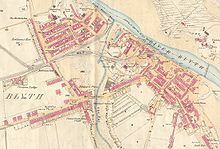Blyth Dry Docks & Shipbuilding Company
The Blyth Dry Docks & Shipbuilding Company was a shipbuilding company in Blyth, Northumberland . The shipyard existed from 1811 to 1967 and, in addition to some innovative ship types, also built the first British aircraft mother ship , the Ark Royal .
history
Beginnings
Shipbuilding began in 1811 on a stretch of the south bank of the River Blyth now called Wimborne Quay. Initially, smaller wooden sailing ships were built. In the 1840s Beaumont & Drummond acquired the shipyard, which in 1863 sold the company to Hodgson & Soulsby , who initially continued to build and repair wooden ships. Hodgson & Soulsby built the first iron ship in Blyth for the Russian government in 1880.
As a limited company
On March 2, 1883, the company was converted into a limited company and then traded as Blyth Shipbuilding & Dry Docks Co. Ltd. With the construction of the fifth ship, the shipyard establishes a connection to the shipping company Stephens and Mawson in Newcastle, whose senior partner Daniel Stephens first became shipyard director and later chairman of the shipbuilding company in Blyth. In the years from 1896 to the beginning of the First World War, the shipyard built 17 liner and tramp freighters, as well as a number of necklaces . A number of seven ships of the Archdecker type are known. The first ship of this type was the 1912 Sheaf Arrow of the shipping company WA Souter from Newcastle. The Archdecker are built according to the designs of the engineers Ayre and Maxwell Ballard. The special feature was the arched design of the transition from the outer skin to the main deck, which ensured increased longitudinal strength and enabled a cargo space without supports and annoying frame fittings.
First World War
On September 5, 1914, the shipyard's most famous ship, the aircraft mother ship Ark Royal, was launched. In addition to the Ark Royal , the shipyard also built nine trampships and colliers as well as six flower-class sloops and ten non-propulsion dropships of the X-lighter type for the British Admiralty during the Second World War .
Between the wars
In the years 1920 to 1925 the shipyard built seven colliers, four of them were corrugated , that is, they were provided with two or three horizontal bulges on the hull, which improved the flow behavior towards the propeller and led to a higher speed. Daniel Stephens died on March 19, 1925 at the age of 80. The shipyard declared bankruptcy due to a lack of orders and closed its doors in the following May 1925.
In November 1926, Robert Stanley Dalgleish, a ship owner from Newcastle, acquired the yard and renamed it Cowpen Dry Docks and Shipbuilding Company . He merged the shipyard with Ritson's Shipbuilding and Engineering Company. As early as 1930, the shipyard closed again in the course of the shipbuilding crisis.
Shipbuilding for the British Admiralty
In the summer of 1937 the shipyard was reactivated as the Blyth Dry Docks & Shipbuilding Company to build a number of ships on behalf of the British Admiralty. There were five frigates of the River class and two of the Bay class , and two corvettes of the Flower class and seven of the Castle class built. Plus ten came minesweeper of the Bangor class and a class of small aircraft transporter type Blackburn . The German combined ship Hanover was also converted into the escort carrier HMS Audacity there .
post war period
In 1947 the shipyard with its four slipways and five dry docks became the property of Mollers (Hong Kong) Ltd. and began building turbine-powered liner freighters for the Lancashire Shipping Company, which is part of Moller's Shipping. From 1949, eleven tankers for different owners followed. In order to be able to build larger ships, in particular tankers and ore carriers, the largest new slipway was extended to around 180 meters in 1954.
After four coastal steamers had been built for the shipping companies Stephenson Clarke and William Cory and Sons in the 1960s, some bucket and hopper dredgers and three suction dredgers followed in 1966 . In 1967 the shipyard was finally closed. Some companies used the dry docks for ship repairs and scrapping. The Bauhellinge were demolished in order to build a paper and wood handling facility for the Port of Blyth .
Individual evidence
- ^ Maxwell Ballard: A new Design of Merchant Vessel . In: The Marine Engineer and Naval Architect . 1911.
- ^ Alan McClelland: Milestones in tramp ship development . In: Roy Fenton (Ed.): Ships in Focus Record . Ships in Focus Publications, 1996, ISSN 1363-1675 .
literature
- Norman L. Middlemiss: British Shipbuilding Yards . Volume 1: North-East Coast. 1st edition. Shield Publications, Newcastle-upon-Tyne 1993, ISBN 1-871128-10-2 .
- Lloyds Register of Shipping (Ed.): Lloyds Register of Shipping . Appendix 1979-80. Lloyds Register of Shipping, London 1979.
- Lloyds Register of Shipping (Ed.): Lloyds Register of Shipping . List of Shipowners 1967-68. Lloyds Register of Shipping, London 1967.

